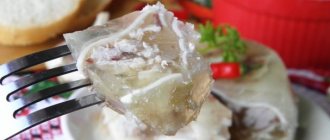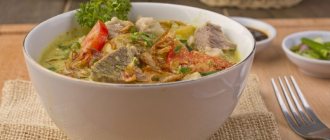When jelly and jellied meat appear on a menu or cookbook, the question naturally arises as to how these two dishes differ. Without going into details, we can say that these are two identical dishes with different names. But in fact, there are quite a lot of differences between them, both in the composition of the ingredients and in the cooking technology.
What is jelly
Jelly is a jelly-like dish thickened in the cold from boiled meat and the broth in which it was cooked. To prepare the dish according to an authentic recipe, be sure to take beef or veal head and legs so that the jelly sets and does not spread, and also has a deep, interesting taste.
The ingredients for the jelly should be cooked for at least 8 hours.
Jelly in its unchanged form is better known in the northern regions of Russia, where it is prepared according to the cookbooks of the USSR, and always eaten with horseradish. This dish has long been respected by representatives of professions who spend all day outside: hunters, shepherds, fishermen. They can take the jelly with them and consume it either cold or heated over a fire.
To sum it up...
Properly preparing the most delicious aspic, jelly or jellied meat in your home kitchen will not be difficult even for an inexperienced cook. These dishes do not require any special painstaking operations during their preparation, as well as incomprehensible and overly complex procedures. Everything is extremely simple!
If this is your first time preparing one of the above cold dishes, then first of all, study the appropriate step-by-step recipe with photos in this section of the site. All instructions are written in as much detail as possible. In addition, step-by-step photos in the recipe will help you quickly navigate and understand how to correctly perform a particular procedure.
Do you doubt that you can prepare aspic, jelly or jellied meat better than your beloved grandmother... In vain! The recipes for preparing these dishes are very simple and require only strict adherence to the specified recommendations.
Jellied meat is a cold meat snack with a jelly-like consistency. It is prepared on the basis of bone broth from pork shanks, ears, beef on the bone or homemade chicken. The more varieties of meat, the richer the taste of jellied meat. The amount of meat should be at least 70−75% of the total mass.
Jelly and jellied meat differ in the method of preparation and even in appearance
The jellied meat is cooked over low heat for at least 6 hours. The cooking process is divided into three stages: first, add the shanks and ears, after 1 hour - the rest of the meat, and 1 hour before the end of cooking - roots and spices. The broth is filtered and cooled. Properly prepared broth does not need to be clarified; simply strain it. The meat is chopped into small pieces, placed in special molds or deep plates, poured with broth and left in a cold place to harden.
The dish is served with horseradish or mustard seasonings
Jelly is a meat dish for a cold table, prepared by prolonged cooking and boiling of the meat parts of the animal. It is made from beef - head, legs and tail. These parts of the carcass should be well cleaned and kept in salt water. Place all ingredients in cold water at the same time, bring to a boil and reduce heat to low. The jelly is cooked for at least 7-8 hours.
The broth turns out dark, so it is lightened with protein and lemon juice. The meat is taken apart, laid out in molds and filled with broth. For seasonings, only crushed garlic is used.
What is aspic
Jellied meat is a composite dish of meat or poultry, as well as the broth in which they were cooked, with the obligatory addition of spices and vegetables. It is kept in the cold until it completely hardens in the form of jelly. In order for the process to be guaranteed to occur, the recipe calls for preparing the dish mainly from legs, ears, heads, tails - parts of the carcass containing a maximum of gelling substances.
Meat, vegetables and spices for preparing jellied meat can be selected according to your taste
Jellied meat is common in the southern and southeastern regions of Russia, Belarus and Ukraine. In various national cuisines, there are analogues that differ slightly in recipes, spices used and types of meat. For example, in Georgia it is muzhuzhi, in Moldova it is rooster jelly, in Bulgaria it is pacha.
What is the difference between jellied meat and jelly?
JELLY, -dtsa, m. Same as jelly.
Source: Ozhegov. Dictionary of the Russian language.
1.Jellied meat in Russian cuisine most often means jelly (see). Most often this name is applied to jelly in the southern and southeastern parts of the Russian regions, while in the north and northwest they say “jelly”. In addition, beef jelly is necessarily called “jelly,” while a pork product is called “jellied meat.”
JELLY. The Russian name for cold table meat dishes prepared from veal, beef, pork by prolonged cooking and maximum boiling of the meat part and thickening of the broth. Other nations also have similar dishes (see rasol, muzhuzhi, jellied meat), but in their preparation there are always national differences regarding either the composition of the products, or cooking methods and seasonings.
Russian jelly is made from beef or veal; pork jellies are common in regions of Russia close to Ukraine and Belarus. The head and legs of the animal go into the jelly. One of the main conditions for good jelly is preliminary thorough cleaning of these products: singeing, washing in several waters, scraping.
Another condition for real jelly is that it contains the entire head (including the brains, tongue) and all four legs. Usually, in recent decades, this condition is not met, only waste is left for the jelly, and this deprives the jelly of its characteristic taste and value, forcing the use of gelatin in its preparation, while the complex preparation of all traditional parts gives natural gelling, making the jelly first-class and tasty snack dish
- Jellied meat, in contrast to meat jelly, in the northern and central regions of Russia is called cold boiled fish, frozen in its own boiled broth and served cold. In order not to be confused with pork jellied meat, this dish is also called cold. Cold from sturgeon, cold from veal - these terms show that they are used in cases where the product is capable of producing a gelling substance naturally, without the use of gelatin, by simply setting in the cold - and hence it is called cold to distinguish it from similar gelled aspic dishes ( see aspic).
- Jellied meat in Belarusian and Ukrainian cuisines is often called summer cold berry soups - mainly from raspberries, wild strawberries, strawberries and blueberries. They are made with either light sugar syrup or milk, but in both cases they are served very cold. Due to the fact that such soups began to be perceived as separate, special dishes not so long ago, a special name has not been developed in folk cooking, and therefore they are called either by their composition - berry soups, berry soups, or by their seasonality - jellied meat, since in This seems to be their main difference and advantage in the hot summer.
It must be borne in mind that to prepare berry jellied meats, half of the berries in them are pureed, and this juice and pulp are added raw to the cooled syrup. The other part of the berries is sprinkled on top of the jellied liquid for decorative purposes, and thanks to its density, whole large berries always float on the surface, creating the illusion of the entire dish being filled to the bottom with berries.
Source: Pokhlebkin V.V. “Culinary Dictionary”.
The jelly should “tremble”: competently prepared jelly should be visible to the bottom of the eater, shudder under the fork and delight with an amber tint.
Jellied meat is a denser dish, sometimes thickened, like jellied jelly, with gelatin.
Jelly and jellied meat: general points
There are far more similarities in the preparation of jelly and jellied meat than there are differences. This is not surprising, since both dishes are essentially thickened boiled meat in its own broth.
What do jelly and jellied meat have in common:
- the meat for both dishes is cooked at a low boil or on the verge of boiling, with the lid open or slightly open;
- It is periodically necessary to remove foam and fat from the surface of the broth using a slotted spoon, but without stirring the main mass;
- It is customary to salt the broth for both jelly and jellied meat immediately before the end of cooking, or after removing the dishes from the heat;
- water must be poured in advance in the required quantity so that it does not need to be topped up, which will negatively affect the gelling properties;
- Both dishes mainly contain offal - legs, heads, tails, ears and similar not very valuable parts of the carcass;
- It is preferable to take fresh or chilled ingredients, since the use of frozen bones negatively affects the transparency of the food.
Conclusions: what is the difference between jelly and brawn from jellied meat, and jellied meat from aspic?
Even if the interest is purely theoretical, it must be satisfied. In the end, the housewife has the right to know what she gets out of it, and what is the difference between brawn, aspic, jelly and jellied meat. The difference can be summarized in the following points.
- Meat products used for broth. For the jelly you only need beef; the rest can be filled with almost anything you have on hand.
- Structure. The jelly is more fluctuating and soft, the rest of the “twins” have a strong jelly.
- Color. Jellied meat and aspic are lighter, jelly is definitely dark, brawn varies in shade depending on what went into it.
- Bookmark order. All meat components are put into jelly at once, into the rest - depending on how much time it takes to boil certain varieties/types of meat.
Another point in which jelly differs from jellied meat (and other similar dishes) is the cooking time. Due to the fact that it only uses beef, it will simmer on the stove for 3-4 hours longer. The brawn is also close to it, if the prevailing amount of the meat set is the same beef.
Needless to say, none of the mentioned dishes can be found in modern times in an authentic form. Housewives usually combine cooking methods and base, focusing on their preferences.
Classic jelly recipe
The jelly takes a long time to prepare, but the result is worth it. The main thing for everything to work out is to strictly follow the recipe.
Classic beef jelly
Ingredients:
- beef head and 4 shanks;
- onions – 2 pcs.;
- parsley root - to taste;
- bay leaf – 3 pcs.;
- garlic – 1 pc.;
- black peppercorns - to taste;
- salt - to taste;
- vinegar – 1 tsp.
We scorch the beef offal, chop it into small pieces and soak in clean chilled water for a couple of hours. We rinse them thoroughly, clean them if necessary, put them in a large container - a saucepan or basin, based on the fact that you need to fill everything with water, a volume twice as large as the meat itself. We also put onions, garlic, parsley, bay and pepper there. Cook everything for about 8 hours over low heat, promptly removing any foam that appears. We take out the beef, separate the meat and chop it finely, and send the bones back into the broth to cook for another couple of hours.
After the broth has evaporated to such an extent that it becomes approximately the same volume as the meat, add some salt and vinegar, quickly bring to a boil and turn off the heat. Separate the liquid from the rest of the mass and filter so that the jelly is transparent, without solid particles.
Place the meat in low ramekins or a large bowl and pour the broth evenly. Let it harden in the refrigerator or, in the cold season, outside. Serve with horseradish and mustard.
How to prepare jellied meat
Jellied meat is a meat snack cooked in strong bone broth. Due to the large amount of bone broth, the dish turns out jelly-like, and even at room temperature it retains this shape. Jellied meat is loved for its rich meaty taste. And the unique aroma of this dish is obtained due to various seasonings and spices added to the meat broth during cooking.
This dish is usually served cold; it is usually accompanied by spicy seasonings - mustard, horseradish, etc. It is served along with appetizers before the first or second courses.
Usually, first they cook pork legs, a moto, and part of a pig's head. After boiling, after about 50 - 60 minutes, add pieces of beef with bones and chicken carcass. Due to the fact that several different types of meat are used when cooking jellied meat, the unique aroma of this dish is created.
Usually jellied meat is cooked over low heat for about ¼ day. About 50 - 60 minutes before the end of cooking, add parsley roots, dill, garlic, onions, carrots, bay leaves, black peppercorns, salt and other spices to taste.
After cooking, the broth must be strained (through a colander or gauze folded in several layers). The meat must be removed from the bones, cut into small cubes and placed in special deep molds about 2/3 full and filled with strained broth. You need to cool the jellied meat in a cool place, preferably in a draft.
Classic jellied meat recipe
Jellied meat allows the housewife to use her imagination when preparing, replacing types of meat, spices and vegetables to her taste. Therefore, each time the dish will be slightly different from the previous version.
Jellied meat with carrots and boiled eggs
Ingredients:
- pork leg – 1 pc.;
- beef shoulder – 0.5 kg;
- carrots – 2 pcs.;
- onions – 2 pcs.;
- bay leaf – 3 pcs.;
- garlic – 1 pc.;
- parsley root – 50 g;
- black peppercorns – 10 pcs.;
- salt - to taste.
We wash the meat, if necessary, then additionally clean it of bristles and other things, put it in a saucepan, and add onions, onion peels, peeled carrots, and parsley roots. In this case, onion peels are used to give the broth a beautiful, slightly golden color. If you want it to be transparent or close to it, then we throw out the husk.
Fill the prepared products with water 3-5 cm above their level, bring to a boil, then reduce the heat and cook at the brink of boiling for 6 hours. An hour before cooking, add pepper and bay leaf.
At the end of cooking, strain the broth, for example, through gauze folded several times, to prevent the ingress of boiled seasonings and debris, as well as to ensure the most transparent consistency. Separate the meat from the bones, separate it into fibers and cut into small pieces. Chop the garlic and mix with the meat; add chopped boiled carrots if desired.
We transfer the prepared products into molds or into one large form. Salt the broth, pour it over the meat and vegetables. Let it stand for half an hour at room temperature and send it to finally harden in the refrigerator for 8-12 hours.
Difference in cooking technology
Despite a more or less similar set of products, the technology for preparing snacks is significantly different.
The housewife will need no more than six hours to cook the jellied meat.
- First, those meat products that contain the most gelatin are placed in cold water - these are ears, shanks, tails, hooves.
- An hour after the start of cooking, it’s the turn of chopped poultry, pulp on the bone.
- And an hour before it’s ready, add all kinds of roots and spices to the pan with the rest of the ingredients.
- After cooking is complete, the meat is removed from the broth and separated into fibers, which are sent to pre-prepared containers. Boiled chopped carrots are sometimes placed on top of the meat.
- Strain the broth as desired, achieving greater transparency, and pour it over the prepared meat.
- After this, the jellied meat is sent to the refrigerator to harden.
With jelly the situation is somewhat different.
- First, all its components are soaked in brackish water for several hours, after which they are sent to a pan with cold water at the same time.
- The jelly is boiled for at least eight hours, most often ten or even twelve, which is why the broth turns out not only dark, but also cloudy.
- After the cooking time has come to an end, the meat is removed from the broth and separated into fibers.
- Bring the liquid to a boil again and remove from heat. Then let it cool a little and add grated garlic with beaten egg white. The latter has the property of curling up and absorbing all the debris.
- The cooled broth is filtered through several layers of gauze, after which it is poured over the previously prepared meat.
- The dish is sent to the refrigerator to harden.
The resulting jellied meat is more transparent, lighter and harder than jelly.










